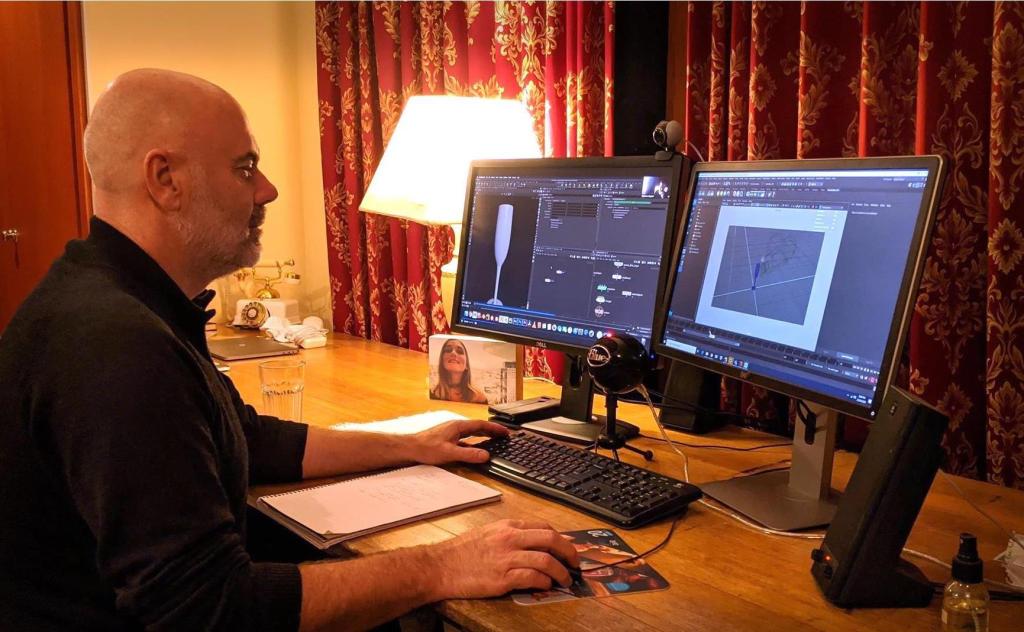The COVID-19 shutdown has forced all educators to move online fast, cobbling together classes with new technology and making it all up on the run.
We talked to four teachers, all dealing with very different kinds of students and subject matter. The consensus? This is a challenging and frustrating time. Preparation takes longer, delivery is more intense, and expectations must be kept in check. A sense of humour and an eye for absurdity helps a lot.
Surprisingly, some students are flourishing and getting more attention than ever, but it’s not ideal. The system relies on the conscientiousness of teachers, and these four are doing their best to adapt.
The VFX and Animation Teacher: Daryl Munton
Daryl Munton is an AACTA award-winning VFX supervisor who’s worked on everything from independent Australian films (like the animation Nullarbor, which he made as part of the Lampshade Collective) to huge international features like Pacific Rim: Uprising and Captain America: The Winter Soldier. Munton is currently the second-year VFX and animation teacher at the Melbourne campus of the Academy of Interactive Entertainment where he teaches generalist visual effects and animation, as well as specialist topics like Simulations and Particles and Grooming.
What are the main tools or delivery platforms you’re using to deliver the teaching at this time?
The software we teach is Autodesk Maya, sideFX Houdini, Photoshop, Substance Painter, 3D Equalizer, Nuke, and a load of other smaller utilities and software. I was delivering the content on campus face to face, but more recently we’ve been teaching from home using Zoom, which is amazing for us. I can show students what I’m doing or they can show me their screens so I can fix any problems they have, and through that same platform, I can request control of their machine and actually work on their machine and fix problems in front of their face. I’ve been amazed at how easy it is.
How much experience had you had with online delivery before this?
In the past, I had a couple of online classes through the year to teach my specialisation to students around the country who were interested in that area, but had really struggled with it, to tell the truth. I wasn’t very prepared and I don’t think the students were very engaged. From that experience, I was dreading having to do it.
How has the shift to online affected your methods?
So far I’ve noticed that it’s a bit more intense for me. It takes more of an effort to keep the students involved which means its more of a performance than usual. I guess the biggest shift is really making a bigger effort to engage with quiet students every day; making a conscious effort to see what they are doing and getting them to show and tell the class what they have been up to. It’s way easier for a quiet student to never be involved, whereas in the classroom, I can walk around and look over their shoulder, or actually see if they are asleep. Not now!
What are your top three tips for making this work?
- The first would be to make a habit of asking everyone to show what they are doing. A dailies session in the morning and at the end of the day. Bring students into the session actively.
- Find ways to make things a bit different from time to time, like inviting other teachers in to banter a bit during a lecture so they are not just listening to me all the time.
- Find ways to make it worth a student’s while to come into the session and interact – like good feedback and praise. I’m still working it out.
What are the biggest difficulties?
I feel fairly alone now and miss going to work in a place with co-workers, having those daily discussions and teamwork. Keeping students engaged, while not wearing myself out trying to be a performer all the time, is difficult. It feels like more of a performance now.
Are you enjoying it at all?
I am enjoying some parts of it and I’m also less distracted. I’ve found marking assessments is way easier from home. With no-one around, I can power through them. I have less people asking things of me, and I get silence in my room to concentrate on the things I research to help students. I love solving a problem and making pretty pictures. When I get quiet time to do this, I really dive deep into it and get lots more done. I’m really enjoying not commuting too – I get so much more time to do things now.
Do you get the sense that your students are finding this time difficult? Is motivation a problem?
Actually, I think they are doing okay. There are some parts of what we do that are harder now, but in other parts the isolation makes easier. Just like me, I think they are more focused. I’m feeling that motivation isn’t really a problem.
Some of the more computer-intensive processes like rendering are harder from home. On campus we have 200 machines to render on, but now they have one or two computers, so we have to render everything a bit smaller for now and wait till we get back to school to do better versions. I’m feeling that motivation isn’t really a problem.
Have there been any unintended consequences or funny moments?
In the first week of online classes,we were using Zoom and one day I forgot to end the meeting. I went and had dinner. When I came back up to my room, I could hear people talking. I realised I had left the meeting going and two of my quietest students were working and chatting in our online classroom. They didn’t know I could hear them. After realising they were really opening up to each other for the first time, I turned down my speakers and just left them to it. They had never really talked in class, but now in the online world it made things easier for them. Cute. Oh, also, yesterday when I was lecturing, the wooden screen I have behind me to hide the room fell on my head mid-lecture. That wasn’t fun.
What’s surprised you about online teaching?
I’d assumed I wouldn’t be able to develop relationships with anyone online in this situation, but it doesn’t seem to be true. I’m getting to know a different set of students who are more vocal online than they were face to face.
The Primary School Teacher: Janine Wiggins
Janine Wiggins became a primary school teacher ten years ago, ‘after a career change from a string of thankless jobs’. She now teaches at Yarraville West Primary school, teaching grade 1 and 2 composite class three days a week, and the other two days works with students who need extra support with literacy. She’s also completing a Master of Learning Intervention for students with specific learning difficulties and says understanding and helping struggling students is one of her passions.
What are the main tools or delivery platforms you’re using?
We are using Seesaw for assigning daily tasks with students uploading their work via this platform for feedback and announcements, and Webex for face to face morning wellbeing checks and making sure students feel connected.
How much experience had you had with online delivery before this?
None before this time. I have been a student at university with subjects run online but never as a primary teacher have I delivered lessons remotely.
How has the shift to online affected your methods and your workload?
The method of teaching remotely has changed completely – there is a lot of hands on. The method is different because in the junior years there is a lot of explicit instructions required for tasks and many students struggle with working independently. The tasks we are assigning for students are tasks we hope they are able to do independently knowing that parents may very well be working from home and unable to spend the time going through the tasks.
The time spent thinking and planning about targeting the work for students remote has dramatically increased. It seems every time I sit down and think I end up on the computer trying to find a way to deliver a lesson that is differentiated and accessible independently by all students.
The cognitive load is far greater when you take into account learning the new delivery platforms, learning a new and best way of delivering the curriculum to all students, and trying to abide by government protocols in a daily changing situation.
What are your top 3 tips for making this work?
- Try to work regular hours rather than answering emails at all hours and all weekend.
- Don’t sweat the small stuff and be kind to yourselves. There is a lot going on in the world, and we need to cut ourselves some slack.
- Have a sense of humour and have a laugh with colleagues.
What are the biggest difficulties?
I find the biggest difficulty is the daily changing of the goalposts, which means a mountain of emails to trudge through. You then need to work out what the most recent expectations are, and apply them to tomorrow’s lessons/schedule which makes the work/life balance even more difficult.
Are you enjoying it at all?
I am really enjoying using the technology to engage families in the education process along with the students. I think this is a real positive out of this situation. I would hope that in some capacity I would continue using the platform to continue the connection between school and home.
Do you get the sense that your students are finding this time difficult? Is motivation/supervision a problem?
I don’t get the sense that the students in my grade, or my school for that matter, are unmotivated. It is quite the opposite for the junior years. They are loving the new technology and chatting with classmates and the teacher. I think because they have been in isolation they are excited for some structure and routine back in the households.
Have there been any unintended consequences or funny moments that you’d like to share?
Some of my work colleagues have kept us all entertained with their hilarious isolation antics. Wow, there are some clever and creative people I work with.
What are the most common misconceptions or assumptions in the community about online teaching?
I feel the biggest assumption is that parents are ‘home-schooling’ but we as teachers are actually delivering a curriculum and we are putting a great deal of thought and effort into getting it right for all students.
Another assumption I believe there is in the community is that teachers want online teaching. Teachers did not create this situation, but we are a great profession that can adapt very quickly for the best outcomes for students, and ourselves.
Your bio – and anything else you’d like to plug here – feel free to big yourself up. 🙂
I have been teaching over 10 years after having a career change from a string of thankless jobs. I am passionate about helping students that struggle with learning difficulties for whatever reason at school. Hence why I am doing a Masters of Learning Intervention to try and understand and help more.
The Academics
Mel Campbell
Mel Campbell is a widely published freelance cultural critic, copy editor and the author of three books, including her latest, a romantic comedy novel, Nailed It! (2019), co-authored with Anthony Morris. You’ve probably read Mel’s film and television reviews right here at Screenhub. Mel is currently teaching at the University of Melbourne in an undergraduate subject called Understanding Australian Media and a postgraduate subject called Writing and Editing for Digital Media.
How much experience had you had with online delivery before this?
Real-time online teaching is new to me, but I’ve previously used online learning management systems (LMS) to share lecture recordings, readings, resources and assignment information, and to manage discussion forums and marking. At different universities, I’ve used Blackboard, Moodle and Canvas.
How has the shift to online affected your methods?
The hardest thing was getting used to running tutorials in Zoom. I’ve always been a confident speaker and am used to my lectures being recorded, but I’m used to being able to direct students’ attention quickly and seamlessly between focusing on me talking to deliver the material; the PowerPoints and videos shown on the screen in the classroom; me writing on the whiteboard, and large-group and small-group discussions. Zoom is difficult because it highlights only one media element at once.
Weirdly I have found some of the students really come alive in the chat – maybe because chat is a native media form for them, and maybe because it takes the pressure off them being able to compose their ideas. I feel that this less confrontational approach benefits those international students who aren’t used to the conversational approach of Australian university tutorials and who previously felt uncomfortable stating their opinions and challenging classmates and teachers. You don’t feel ‘put on the spot’ as much with online teaching.
However, I’m finding Zoom is not a good way to run supervised ‘class activities’. I find it’s much better for explaining things and answering student questions in real time. Online teaching needs to incorporate more self-directed learning, combined with video conferencing sessions where students can check back in with their teacher.
Your top three tips for making this work?
- Before class I plan everything I’m going to show, in order. I still use PowerPoint, but on Zoom I share only the part of my PowerPoint screen that shows the slide. That way students get to see all the key visual material, plus my live commentary, and they can offer feedback using the Zoom chat function, while I can see all the slides and the notes just as I previously would have in presenter mode. I also like to line up the URLs I plan to use in class in a browser window with the tabs organised in the order I plan to use them. That way I can share my browser screen with students with a minimum of faffing about with the tech. It makes me feel more confident that the class will run smoothly.
- I’ve found the chat function is the most useful part of Zoom because I can use it as a ‘whiteboard’ to write things and narrate them as I do, and students can also ask questions and discuss things.
- And rather than looking at people’s faces on my screen, I look straight into the webcam like it’s someone’s eyes. That gives a better illusion of eye contact and, for me, it helps me feel less self-conscious and less reminded of the fact that dozens of people are staring at me.
What are the biggest difficulties? Are you enjoying it at all?
I have always hated video calls and only used FaceTime and Skype begrudgingly, so I was really worried about how I would look onscreen, and looking foolish in front of students for not being able to work the technical aspects of Zoom. Lots of students don’t have their cameras switched on so it can feel like you’re talking to nobody, but paradoxically the feeling of being watched is more intense than in a classroom.
The performance aspect of it can be exhausting. After three 90-minute Zoom tutes in a row I’m totally wiped out.
Any unintended consequences or funny moments that you’d like to share?
Oh, my bloody cat likes to wander around in the background of the Zoom and sit on my desk intruding into the frame. I was so embarrassed and thought it was unprofessional, but my students loved seeing him and have mentioned him in their emails.
What are the most common misconceptions or assumptions about online teaching?
One of the things I’m realising is that you can’t translate teaching directly online and have it be exactly the same. Even if you have technological tools that replicate most of what you can do in a real-world setting, you’ve removed most of the in-person cues that teaching usually uses – and that teachers intuitively rely on. You can’t expect the online classes to take up the same amount of time – they need to be shorter or have more breaks – and you need to account for much more student follow-up in terms of emails, Q&A discussion forums, and so on.
Obviously I’m teaching adults and we expect them to be enthusiastic and engaged. I imagine that primary and secondary teachers would have that extra level of complication with having to engage not just with the students but with their parents as well, who are acting as unwilling volunteer teaching aides.
Matilda Dixon-Smith
Matilda Dixon-Smith is a freelance journalist, author and a casual academic. Through COVID-19, she is writing a serialised romcom via e-newsletter, The Broken-Heart Brigade. She lectures in creative writing, publishing and editing at Melbourne University and Deakin.
How much experience had you had with online delivery before this?
Almost none! We do deliver a very small amount of content online via our learning management systems (LMS), and at Deakin there is a Cloud (online learning) cohort for the classes I teach there (taught by other academics, while I teach the on-campus cohort). But as far as online teaching goes, it has been a very quick and steep learning curve for me and my students.
How has the shift to online affected your methods?
My colleague at Deakin, Anna Spargo-Ryan, started off this semester with a fairly large cohort in the Cloud campus, and she gave them a bit of advice that’s stuck with me: learning online will never replicate the regular classroom environment. So I was prepared, when the decision was made to move across to online learning, that it would be an entirely different experience to teaching on campus. The reality of that is still quite intense, and often very frustrating.
I teach mostly seminar classes, which combine lecturing and workshopping in two-hour intensive classes. This kind of teaching just does not adapt well to online learning. So the transition has been difficult, in large part because the outcomes are totally different but we’ve been unable to officially adjust our assessments or expectations mid-semester, so we are teaching with objectives that no longer make much sense in the radically changed learning (and world) environment.
For the first couple of weeks online, if students were even showing up in our online classrooms, I was pleased and impressed to see them there and engaging at such an insane time. It’s nearly impossible to answer this question because, even though we have been teaching online for a few weeks now, we’re still muddling through the process of online delivery and the management of student wellbeing. It’s a strange and difficult time to be teaching or learning.
Your top three tips for making this work?
- The first tip is obvious: throw away any expectations you have from face-to-face learning. The online teaching environment is so fundamentally different, trying to replicate the regular classroom will just create more confusion and slow down progress online.
- It’s important to manage your expectations (and your students’ expectations – and to hope your institutions have managed theirs as well) regarding what will realistically be achieved in this first term/trimester/semester post-online transition. It’s likely we will all learn less, have different results and feel frustrated by the process.
- My final tip is to try to be adaptable: just because your institution wants everyone on Zoom, doesn’t mean that’s what will work for your lessons. If your classrooms are usually heavily reliant on in-class exercises and group work, as mine are, think about how that work can be reconfigured for online study, because delivering that in a two-hour online video conference is going to end up messy. Perhaps use this as an opportunity to tidy up and streamline your syllabus delivery.
What are the biggest difficulties? Are you enjoying it at all?
The biggest difficulty is probably how much energy and effort online learning interactions require, with such diminished returns. It’s utterly exhausting to prepare and deliver classes online, to monitor students in the online environment – and it goes both ways. My students (everyone’s students) are struggling immensely with the transition. And the appearance of blank faces on a video conference screen as you deliver a seminar can be truly disheartening.
To be honest, I’m not enjoying it. It’s tiring, frustrating and ultimately disappointing to see students who should be thriving having to wade through this improper learning environment as we all muddle through. I love teaching, but I miss the comfort of the classroom and I feel acutely that I’m not providing for my students.
Any unintended consequences or funny moments?
One unintended consequence is that we are dispensing extensions to assessments like lollies from a vending machine. It’s unreasonable for us to expect students to be ready to be assessed right now, and many simply aren’t willing to produce work that doesn’t reflect their usual standard, which is understandable. But it makes the marking and administration timeline for our work very difficult to manage. Difficult times for all of us.
But I have relished the few moments we’ve been able to have some lightness in class. I have a one-year-old dog and he loves to hop in on my video seminars (or just sleep in the background while I’m teaching), which means some of my recordings have a soundtrack of light puppy snoring!
What are the most common misconceptions or assumptions about online teaching?
I think, probably, that the transition is easy and that it’s comparable to face-to-face learning. It just isn’t. Universities have known this was a possibility since before semester began, and we should’ve been better prepared earlier, using the time before classes began to make sure we could actually do this thing properly. But this is the consequence of an over-casualised workforce: the tutors and lecturers delivering the classes aren’t given adequate space and time in non-teaching periods to make necessary adjustments to coursework at the best of times.
The other misconception is that we’d all be able to teach/learn with the same hours: everything takes so much longer! I want to make it clear how overworked everyone in education is right now; we’re all doing the best we can, but it’s tough when we’re up against a lot of inflexibility.
(This article was originally published on ScreenHub 23 April, 2020)





